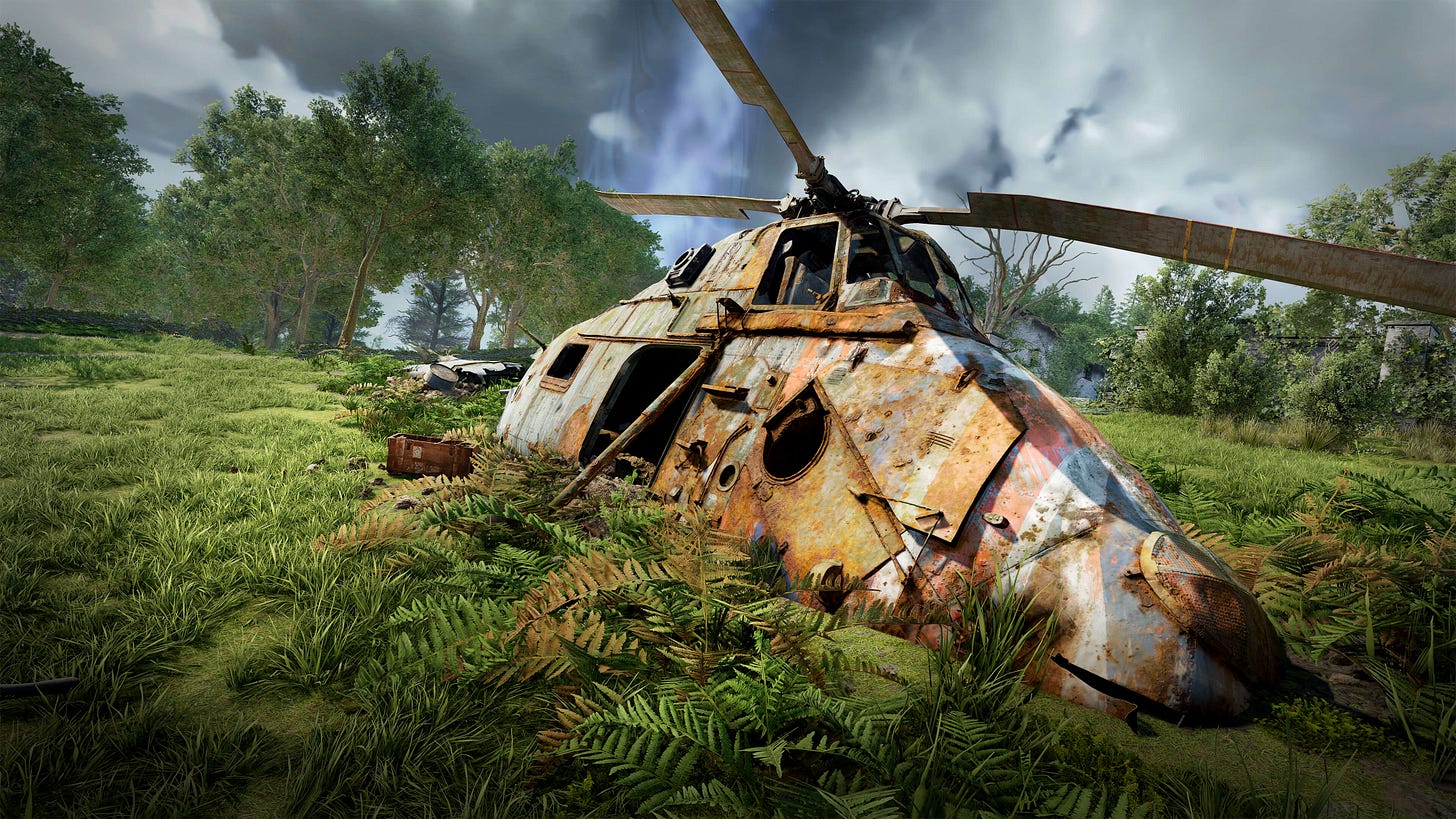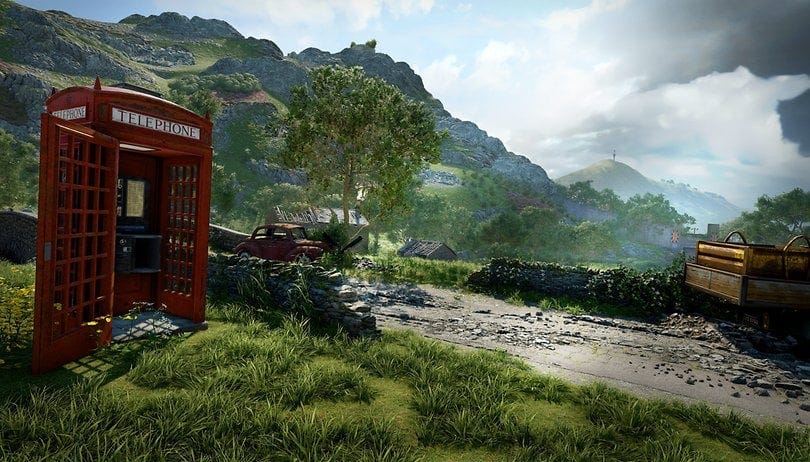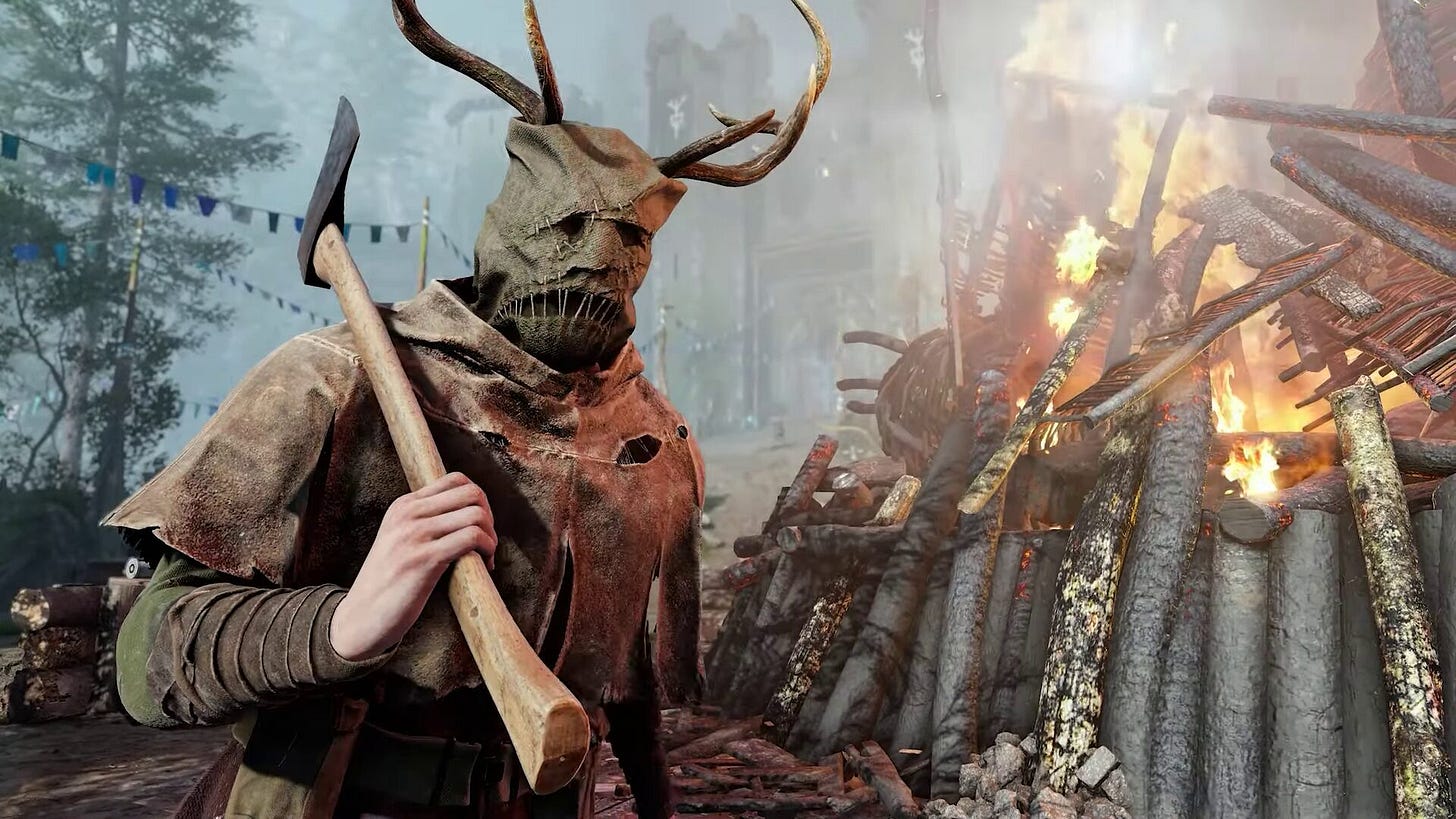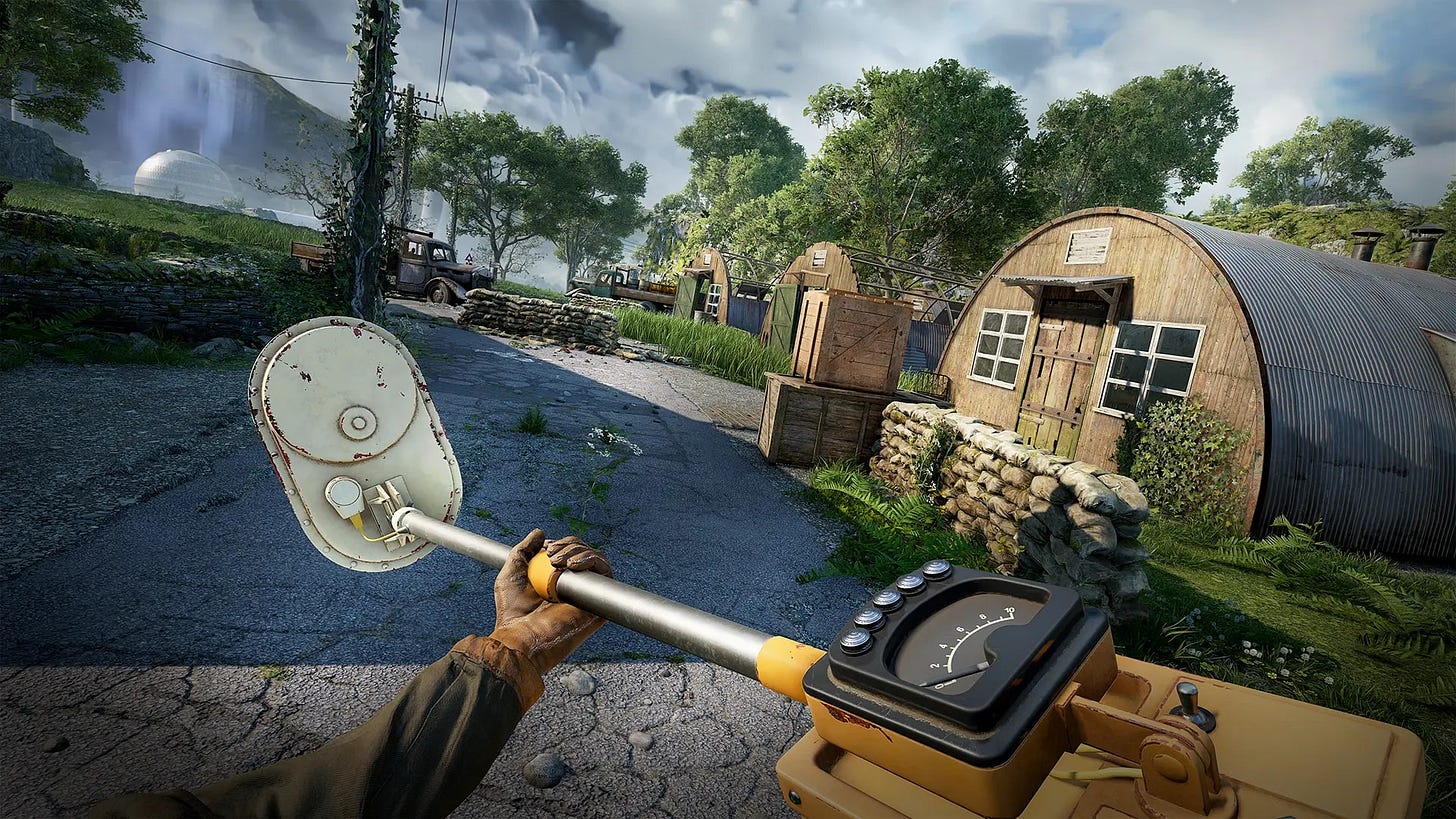'Atomfall' and main story syndrome
A new survival-action game spins an intricate yet limiting narrative out of its very British apocalypse
I just want to investigate this helicopter crash.
Midway into Atomfall, a new first-person survival-action game from Rebellion Developments, I was getting tired of being drawn back into the main story despite my many attempts to simply explore. And here I was, emerging from an underground tunnel into one of the game’s five regions, when I saw some wreckage.
A couple of marauders were poking around it, but I snuck up on the group and dispatched them quickly with my tried and true weapon combo: I shot a few arrows with my bow then charged the survivors and hacked at them with a one-handed scythe.
As an exercise in sneak-and-stealth combat, the game often lacks mechanical polish and convincing enemy behavior; mixing this with an attempt at open-world expansiveness often makes navigating the world feel rote and tedious. But, when I kept things medieval, avoiding the mostly rusty and ineffective firearms I came across in the world, combat was much better. Hence, bow and scythe.
With these nosy outlaws out of the way, I started poking around the chopper. As is often the case when you scratch many of Atomfall’s ruinous surfaces, there was a body, some supplies, and a note. This note led me to a shed in the middle of a nearby railyard, where there was an abandoned camp, more supplies, and, you guessed it, another note.
Both messages described a group of soldiers trying to regroup after their helicopters went down. I wanted to follow this narrative thread through, as mundane as it was. It took me down into a sewer system, out into another of the game’s regions, and into a cellar at an otherwise destroyed home.
And there I found a Russian.
This Cold War-era spy was trying to find his captain, or something like that. I probably would have helped him, but then Atomfall did the very thing I was trying to avoid and kept stubbornly bumping up against: It started to thread what seemed like a time-killing side quest back into its central narrative.
This story begins, as you might expect a story about nuclear Fallout fallout to, in a bunker. You’re lying in bed and awake in a daze, surrounded by thick, protective concrete. Lights are flashing, alarms are blaring, and a man in a Hazmat suit wanders into your room. He’s wounded, and he wants your help.
As with most characters you meet in this game, even those who are part of the main story, you can kill this guy right away without bothering to hear him out or get further instructions. I opted to help him, which doubles as a crafting tutorial: gather nearby supplies, make a bandage, and give it to him.
When I did this, he thanked me by giving me a keycard to get me out of this bunker and, later, into several others. He also issued a warning: “Be careful, everything is a threat out there.”
His point is quickly proven.
Once I exited the bunker, the scenery quickly overwhelmed me. Here I was, smack in the middle of the lush, rocky countryside of what I will later learn is a quarantined section of Great Britain.
But first, another bit of education: Not long after taking in the grassy hills, dilapidated structures and strange, artificial-looking light blue haze in the distance, I see the first of many big red telephone boxes.1
And then it starts ringing, a gravelly male voice on the other end bellowing, “Oberon must die.” These calls continue for the duration of the game, the paranoid voice weighing in on people you meet, almost always telling you not to trust them.
Atomfall’s opening minutes were quite illustrative of its approach to naturalistic world-building. You are given the tools to understand what is happening and how to survive- scavanging, crafting, sneaking, and killing, naturally- but then the game’s many secrets are yours to uncover. Supplies and inventory space are limited, early weapons are weathered and ineffective, and traditional currency has no place here.
Instead, you must take these scant resources and use them to barter for things you need from other people in the world. How many bullets and bandages is a potion crafting recipe worth to you?
For the most part, this minutiae is engaging and well thought-out. As frustrating as it is only being able to carry 20 or so things at a time, including quest items, it’s an engrossing kind of frustration. The game wanted me to feel a little desperate; to rely on a metal detector to find hidden supply caches; to improvise how I would tackle the next group of enemies, and adapt when I ran low on ammo or health items.
You can opt for a more guided experience through the world with traditional objective markers, hints, tutorials, and reminders, or you can wade out into the wilderness with just your compass, wits, and threatening vibes. After about 25 minutes of the latter, and being murdered a few times by well-armed bands of outlaws while wandering mindlessly, I opted for something in between those extremes. I could tell fairly quickly that the game’s combat is not polished enough to make fully roughing it feel rewarding.
No matter how you choose to play Atomfall, though, there is always another trail of narrative breadcrumbs to follow. The story comes into focus gradually at first and then becomes an overwhelming barrage of leads that transform into investigations (aka quests, missions, etc). As you’re forced to choose who to help, alienating other people in the process, your options will start to narrow back down, though I took several of the threads as far as the game would let me without closing others off.
The main backdrop of Atomfall’s narrative is an alternate history take on the 1957 Windscale nuclear plant fires. In the game’s take on events, the facility in Northern England contains secretive research involving an otherworldly organism. The disaster has made this substance airborne, its spores turning those exposed into feral zombies while creating radioactive blue fungal growths across the landscape. The entire region is walled off, the military is deployed, and its citizens are forcibly contained.
The game is set in 1962, five years after the fires. That much time quarantined from the rest of the world and at risk of radioactive illness has everyone feeling restless and desperate, and the driving force of the plot is finding the right person to partner with to get out of the zone.
But who exactly am I to these people? This wasn’t revealed, at least in the way the game unfolded for me. Atomfall takes the idea of a voiceless, blank slate of a character to an extreme. I am a man who wears brown leather gloves and who grunts in pain when falling off a ledge. I don’t know how I came to be in the quarantine zone, and I have no memory of life before it.
As this Man With No Name (or Personality), I stumbled on many of the key players incidentally, just by following various leads I discovered throughout the game world. An early conversation with a trader I found operating out of a random, rundown building led me to one of the game’s main regions, Wyndam Village, which is under the control of the British military. A seeming side quest here led me to the neighboring forest, another of the game’s key areas, where you encounter another faction: The druids, masked and painted cultists who worship the blue substance from the nuclear plant and believe it allows the earth to speak to them in whispers.
This gameplay flow worked quite well at first, making me feel like each new interaction could and would lead to something bigger. I had total control over how this story would play out. If you want a more structured experience, you can choose to spend time running errands for the military, scientists, or a mysterious herbalist in the forest. Or, like me, you can just roam; sneak into a druid stronghold in an old castle simply for the experience, raid a locked-down robotics lab just to see what’s in there.
Its world is easy enough to navigate, but becomes predictable and bland as things wear on. I think this could have been solved with a simple fast track feature, which the game avoids in favor of an underground region with condensed geography. As you progress through the game, you can travel between regions faster, but not as quickly as a simple button tap. Since much of Atomfall involves zigzagging across the different maps, the lack of such a common feature, while intentional, sometimes makes things tedious.
For what it’s worth, though, there are welcome moments of levity as I wandered the different areas, such as a mission update that reads “The Voice on the Telephone Might Help Me Escape,” or an authoritative captain growling over the loudspeaker that, “it seems some of the villagers are unhappy with our recent enforcements of Martial Law.”
Like I mentioned at the start, though, Atomfall’s detours eventually lead back to the main narrative highway; it’s an incredibly intricate storytelling web that I couldn’t help but be frustrated by. My aimless wanderings become a conspiratorial corkboard of overlapping plotlines and character motivations. Something similar to the investigation board interface of Alan Wake II might have come in handy here, as I was left to sift clumsily with competing briefs, notes, and map coordinates that pertain to the same investigation.
Atomfall flirts with the trappings of open-world games but closes off most experiences that don’t relate back to the Windscale plant. Its flickers of supposed spontaneity aren’t genuine.
I play games like this to be swept up not just in a story but as a way of participating in a world as much as it will let me. In other first-person, open region games that share different strands of DNA with Atomfall- like Dishonored or, more recently, Avowed2- there is an effective accumulation of detail as players navigate their fantasy worlds. You are doing more than assassinating a corrupt politician or investigating a fungal plague; when you stumble on notes or overhear conversations, you feel like you’re intruding on private experiences.
These moments have nothing to do with the main stories, and sometimes they have nothing to do with side quests. But they create the feeling that you are in a lived-in world of possibilities, roaming a place where your objectives are not the only ones.
In Atomfall, nearly all realms of experience serve a narrative purpose. It makes sense that escaping quarantine would be on the top of everyone in this region’s minds, but it’s been half a decade since the Windscale disaster, and there has to be more going on.
It wouldn’t be fair to measure the game on this alone, but it was also released just about five years after the start of the COVID-19 pandemic. It has been dropped into a world that has recently known extensive quarantine, that knows what this kind of drastic societal shift could look like. I’m not suggesting that the game’s own crisis should reflect that, but it exists in a kind of disaffected vacuum, however expansive that vacuum may be. Even the aftershocks of World War II, which I heard mentioned briefly, felt more like window dressing than something that had a tangible effect on these people’s lives.
When trying to find rewarding ways into Atomfall (and reader, I really did try), I got the most bang for my buck talking to people. Throughout the 14 or so hours I spent on my initial playthrough, I wanted to spend time with as many stakeholders in this quarantine zone as possible, and then make my decision on who to trust to get me out of here.
The people you meet are distinct and exceptionally well-written; the dialogue is a wonderful blend of weary philosophy, cocky assertions, and whispered negotiations. No one wants to reveal their full hand, or to have those around them know they’re asking for my help, that they needed me to be their errand boy.
When I talked to characters, I could choose responses of various intensities- honest, intimidating, evasive are three recurring ones- but no one seems to know or care who I was; the mysteries in the game’s story are more invested in the high drama of nuclear tests and competing interests.
The voice on the phone seems to know my every move, and could easily be a hallucination of some kind, but following that narrative thread brought me no answers. What good is a heavy case of main story syndrome if, ultimately, the story leaves you just as directionless and confused as you were in the beginning?3
If the game wanted to lean into narrative abstraction or dream logic, then putting all its chips on a satisfying resolution was deeply miscalculated. For all its faults, a game like Bioshock: Infinite handled its revolving narrative door, the descent into a metaphysical void, quite well. Going back to the beginning was the point, and it was more effective because the journey I’d just been on felt transformative.
In Atomfall, this storytelling approach feels less impactful because the game’s swirling, choose-your-own-adventure approach feels limiting and expansive at the same time. Seeing so many story arcs culminate in so little is less a narrative whirlpool and more like circling the drain.
Atomfall is available on PlayStation 5, Xbox Series X|S, and PC.
England!
Lost fans, can you help me out here?







